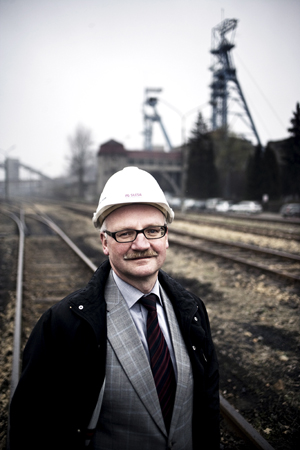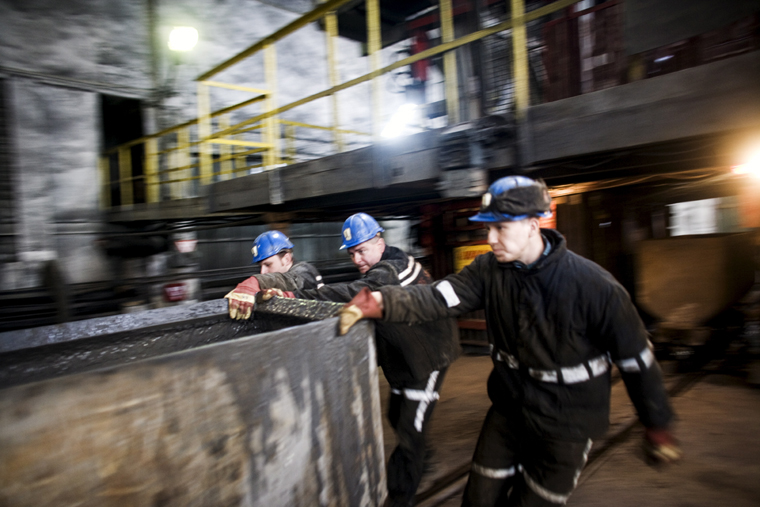Second life in the coal mine
Katowice, Poland. The more than a century-old PG Silesia coal mine in southern Poland has been reborn under new Czech owners. Safety was a determining factor when choosing tunnelling machines. A pair of Sandvik Roadheader MR 340s are now forging the way.
Rebirth. New owners in southern Poland are breathing life into the 110-year-old PG Silesia coal mine where Sandvik’s Roadheader MR 340s forge the tunnels to get to the “black gold”. After many years of restructuring, dwindling production and lack of capital, Europe’s largest coal industry is once again exuding confidence.
Katowice, in southern Poland near the Czech border, is the throbbing heart of the district of mines and heavy industry. Towns, mines, car factories and smoking chimneys are all mixed up here and, since the fall of communism, enormous shopping malls have added to the chaos.
About PG Silesia
PG Silesia was under threat of closure when privately owned Energeticki a Prumyslovy Holding, or EPH, took over the company in December 2010 from the state-owned Kompania Weglowa as Europe’s largest coal producer. EPH is a holding company with more than 20 units that produce electricity and heating and trade in electricity and renewable sources of energy.
Since the acquisition, PG Silesia has doubled its number of employees to the current 1,500. In total, EPH is investing 150 million euros in everything from new machinery to transport systems and plants for processing coal. After the completed upgrade, 3 million tonnes of coal will be mined annually. The reserves of 130 million tonnes will suffice for at least 40 years.
The activity underground is equally intense. Coal has been mined for centuries in the area. In the 1980s, 200 million tonnes of pit coal and 36 million tonnes of lignite were mined throughout Poland annually.
Since then mining has dropped by more than half while imports have increased substantially. Today coal produces 93 percent of the country’s electricity, more than anywhere else in Europe.
“We have difficult years behind us,” sighs 58-year-old Zbigniew Kluka, who spent his entire working life at PG Silesia and now, eight years after his retirement, has returned to help give new life to the underfunded mine. “Once a miner, always a miner,” he says proudly, removing his helmet to wipe the sweat from his brow.
PG Silesia is near Czechowice-Dziedzice, 50 kilometres south of Katowice. For a long time, the life of the mine was considered to have come to an end. The state-owned parent company Kompania Weglowa, which is to be privatized in 2014, lacked resources, and for many years no investments in new machinery were made. Finally the transport system and safety equipment became hopelessly out of date.
It was a depressing sight,” recalls Ewa Szpejna, the mine’s head of communications. “The machines were old and worn out, and you could see immediately that the entire mine was underinvested.” Szpejna, 36, started at PG Silesia in December 2010 when the Czech energy group Energeticki a Prumyslovy Holding acquired the company and its 750 employees.
 Times have changed since then. Investments of 150 million euros have been planned, of which 110 million euros have already been pumped into the company. Transport systems and cleaning and processing plants have been modernized or demolished and rebuilt. Traces of the old days can be seen between the buildings: discarded machinery, rusty tools and electric cabinets with loose cables fluttering in the wind.
Times have changed since then. Investments of 150 million euros have been planned, of which 110 million euros have already been pumped into the company. Transport systems and cleaning and processing plants have been modernized or demolished and rebuilt. Traces of the old days can be seen between the buildings: discarded machinery, rusty tools and electric cabinets with loose cables fluttering in the wind.
Some 250 employees have either retired or left the company, but at the same time 1,000 new jobs have been created, and confidence is growing. “We had become accustomed to promises that were never fulfilled,” says Jacek Kastelik, who has worked in the mine for 21 years and is now PG Silesia’s head of safety. “But now we can see with our own eyes that investments are being made in new machines and fresh new premises.”
Safety is central to the Czech owner, whose goal is to transform PG Silesia into Poland’s most modern coal mine. “As a private company in a state-dominated industry, we want to show off with our exemplary safety,” says Thoralf Klehm, PG Silesia’s vice managing director. Klehm is a veteran who for decades has worked in various managerial positions in coal mines everywhere from Africa and Russia to Kazakhstan and eastern Germany’s brown coal belt.
Safety was a determining factor for the new owner to choose Sandvik’s Roadheader instead of smaller Polish machines that can’t forge tunnels of similar dimensions. The air flowing through is greater in the larger tunnels with a cross-section of 22 square metres, and at the same time there is also space to install more powerful ventilation systems with a capacity to suck out the dangerous methane gas.
Klehm stresses that when choosing machine suppliers, he attached great importance to both their attitude towards safety and their ability to carry out both practical and theoretical training. “We wrote a clause in the contract that Sandvik should have a shift manager and operator in place for the first few months to train our employees and get the whole activity working,” he says. “This was very crucial for us. They hadn’t made any investments in the mine for many years, and the employees needed to receive some thorough training.”
Sandvik, with its headquarters in the town of Tychy, in the heart of the Polish mining district, delivered two Roadheader 340s last year. The 10-metre-long, 52-tonne heavy giants are now slicing out the new roadways, 600 metres below the surface. They are working slowly forward in a compact cloud of dust, just over half a metre at a time before they stop for the newly made distance to be secured with iron sections.
Operator Grzegorz Radon explains that he received five days of intense training both in the mine and at Sandvik’s premises in Tychy. After that he received 20 days of practical training down in the mine, conducted by Sandvik specialists.
“But now we can manage on our own,” he says with a broad smile that lights up his dusty face. “And the machines, they just keep on going, even if we sometimes have to improvise a bit when the rock is harder than normal. Then we try to find a softer place.” Including the operator, 11 people work on the machine at each shift.
Tech specs
Sandvik’s MR 300 series is composed of road headers in four different sizes, from the MR 320, which slices up to 4.54 metres high and 7.6 metres wide, up to the MR 380, which can handle a height of 6.3 metres and a width of up to 7.86 metres.
They all weigh 52 tonnes and are 10 metres long and up to 4.1 metres high. The motor that operates the slicing tool has an effect of 200 kW.
The machines slice everything from coal to stone to salt. More than 250 of them have been sold throughout the world. The MR series has its own transport system and can be provided with steel arch-lifting devices or other equipment. The arch lifting devices are used in PG Silesia’s coal mine to lift the iron sections that secure the roadways.
The pit coal mined in PG Silesia is intended for the border region between Poland, the Czech Republic and Slovakia, where a large part of the three countries’ coal power stations are situated and where the majority of households and many companies use coal for heating. Initially, production is set for a maximum of 1.3 million tonnes per year. But already by mid-2013, when the extension and modernization is completed, mining will increase to 3 million tonnes.
Compared with several other large mining companies in Poland, PG Silesia is small-scale. Kompania Weglowa, the former owner, is the European Union’s largest pit coal company with annual production of 45 million tonnes and 60,000 employees in 15 mines. State-owned Katowicki Holding Weglowy is also a major player, producing 13 million tonnes, and LW Bogdanka, which has now gone public, produces 8.7 million tonnes. Poland is also the European Union’s largest producer of coke: Jastrzebska Spolka Weglowa, listed on the Warsaw stock exchange, sold more than 12 million tonnes in 2011.
PG Silesia may be small, “but the reserves are considerable,” Klehm says. On a piece of A4 paper he sketches an area of the mine that is several kilometres long and wide, with so-called longwalls and different layers or types of rock that are no higher than 2.5 metres but more than a kilometre long. “We are sitting on geologically established reserves of 500 million tonnes as well as industrial reserves of 130 million tonnes,” he says. “And that is enough for at least 40 years.”
Three-quarters of the production is intended for power stations in the region and the rest for heating. No other country in the EU is as dependent on coal as Poland, which produced just over 75 million tonnes in 2011 and imported about 16 million tonnes. The same year coal accounted for 93 percent of the electricity supply and almost 90 percent of heating. With its 38 million inhabitants, Poland ranked 10th amongst the world’s largest coal consumers.
This energy profile contrasts sharply with the drastically increased environmental demands within the EU, where greenhouse gas emissions must be reduced by 85 to 90 percent by 2050 from their 1990 levels. The price Poland must pay for the adjustment, according to Environmental Minister Marcin Korolec, is 1 percent of gross national product up until 2030.
Poland has thus decided to build its own nuclear power plant, in spite of sharp division amongst its citizens between advocates and adversaries. At the start of the next decade, a 3-gigawatt reactor will be put into operation. Ten years later the capacity will be doubled. At the same time, investment is continuing into renewable sources of energy, chiefly wind power and biomass. A third alternative is the so-called unconventional extraction of domestic shale gas that will reduce dependency of gas imports, mainly from Russia.

At present, all this exists only on paper. However, investments are now being made for the modernization of antiquated coal power plants where the grade of extraction is being raised and emissions of carbon dioxide are reduced at the same time that six to eight new power plants are being planned. The driving force is rising electricity prices as well as future costs for emission certificates. Poland is currently exempt from the certificate requirement, but it will have to pay in full for a large portion of its emission rights from 2020 on.
This is the best of all possible worlds for mines such as PG Silesia that are modernizing and reducing production costs. “In our marketing analysis we are counting on stable demand for some foreseeable time,” Klehm says. PG Silesia is not alone in this view. For the first time in a long time, there are plans to start up new mines just as the old state-owned mines are being privatized and will be provided with fresh capital.
A sign of the times is that Poland’s second-richest industrialist, Jan Kulczyk, has applied for permission for geological surveys in Katowice where he plans to start two new mines, investing at least 300 million euros in each one. “One should be careful not to exaggerate, but the fact is that right now we are experiencing something of a boom in the Polish coal mines,” says Andreas Jagiello, head of mining for central and eastern Europe.
Bronislaw Janik, 44, who looks after the squeaking mine hoist high above the pit and who has worked in the mine for 26 years, cannot imagine a future without coal mines. “My father and my grandfather were miners here in PG Silesia. And now my 22-year-old son has started to study rock technology in order to continue the tradition.” Then he snorts disdainfully. “Those people who say that coal has played its part don’t know what they’re talking about.”
Tomas Lundin

/https%3A%2F%2Fsolidground.sandvik%2Fwp-content%2Fuploads%2F2016%2F04%2Fsilesia-coal-mine-Sandvikmining_article01.jpg)
/https%3A%2F%2Fsolidground.sandvik%2Fwp-content%2Fuploads%2F2016%2F04%2Fsilesia-coal-mine-Sandvikmining_article02.jpg)
/https%3A%2F%2Fsolidground.sandvik%2Fwp-content%2Fuploads%2F2016%2F04%2Fsilesia-coal-mine-Sandvikmining_article03.jpg)
/https%3A%2F%2Fsolidground.sandvik%2Fwp-content%2Fuploads%2F2016%2F04%2Fsilesia-coal-mine-Sandvikmining_article04.jpg)
/https%3A%2F%2Fsolidground.sandvik%2Fwp-content%2Fuploads%2F2016%2F04%2Fsilesia-coal-mine-Sandvikmining_article06.jpg)
/https%3A%2F%2Fsolidground.sandvik%2Fwp-content%2Fuploads%2F2016%2F04%2Fsilesia-coal-mine-Sandvikmining_article05.jpg)
/https%3A%2F%2Fsolidground.sandvik%2Fwp-content%2Fuploads%2F2016%2F04%2Fsilesia-coal-mine-Sandvikmining_article07.jpg)
/https%3A%2F%2Fsolidground.sandvik%2Fwp-content%2Fuploads%2F2016%2F04%2Fsilesia-coal-mine-Sandvikmining_article08.jpg)
/https%3A%2F%2Fsolidground.sandvik%2Fwp-content%2Fuploads%2F2016%2F04%2Fsilesia-coal-mine-Sandvikmining_article09.jpg)
/https%3A%2F%2Fsolidground.sandvik%2Fwp-content%2Fuploads%2F2013%2F01%2Fsecondlife-slide2.jpg)
/https%3A%2F%2Fsolidground.sandvik%2Fwp-content%2Fuploads%2F2024%2F12%2FFasloc-SF-Styren-Free-alt.jpg)
/https%3A%2F%2Fsolidground.sandvik%2Fwp-content%2Fuploads%2F2024%2F05%2F1.jpg)
/https%3A%2F%2Fsolidground.sandvik%2Fwp-content%2Fuploads%2F2023%2F01%2FBackground-2-e1674718920429.jpg)
/https%3A%2F%2Fsolidground.sandvik%2Fwp-content%2Fuploads%2F2023%2F01%2FSmart-parts_2_1600x750.jpg)
/https%3A%2F%2Fsolidground.sandvik%2Fwp-content%2Fuploads%2F2021%2F10%2FDSC_2445_B_1600x570.jpg)
/https%3A%2F%2Fsolidground.sandvik%2Fwp-content%2Fuploads%2F2021%2F09%2FRM1_1600x570.jpg)
/https%3A%2F%2Fsolidground.sandvik%2Fwp-content%2Fuploads%2F2020%2F06%2FMining-Machine-Exploded_1600x570.jpg)
/https%3A%2F%2Fsolidground.sandvik%2Fwp-content%2Fuploads%2F2019%2F10%2F47246191292_1600x570.jpg)
/https%3A%2F%2Fsolidground.sandvik%2Fwp-content%2Fuploads%2F2019%2F10%2FHenrik_Ager_foto_oskar_omne0015_1600x570.jpg)
/https%3A%2F%2Fsolidground.sandvik%2Fwp-content%2Fuploads%2F2019%2F10%2FGearingUp_1600x570.jpg)
/https%3A%2F%2Fsolidground.sandvik%2Fwp-content%2Fuploads%2F2020%2F01%2FNAPO190528AL_020_1600x570.jpg)
/https%3A%2F%2Fsolidground.sandvik%2Fwp-content%2Fuploads%2F2019%2F08%2FBasic_1600x570-Greenwood-02.jpg)